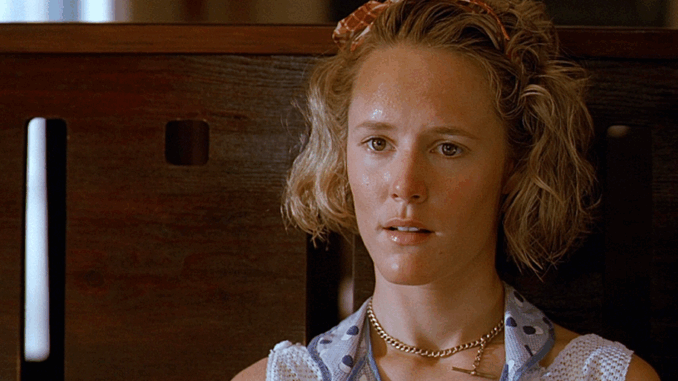
More than three decades after Fried Green Tomatoes hit the big screen, one question continues to stir debate among fans and film critics alike — Was Ninny Threadgoode really Idgie Threadgoode?
The 1991 classic, based on Fannie Flagg’s novel Fried Green Tomatoes at the Whistle Stop Café, is a story about love, friendship, courage, and identity. But beneath its heartwarming surface lies a lingering enigma that fans have been trying to decode for years.
So, let’s dive deep into this cinematic puzzle and uncover whether Ninny and Idgie are truly one and the same — or if it’s simply the greatest storytelling trick in Hollywood history.
The Story Behind Fried Green Tomatoes
Before we unravel the mystery, it’s worth revisiting what made this movie so unforgettable. Directed by Jon Avnet and starring Kathy Bates, Jessica Tandy, Mary Stuart Masterson, and Mary-Louise Parker, Fried Green Tomatoes tells two intertwined stories — one set in the 1980s and another in the 1920s.
Evelyn Couch (Kathy Bates), a frustrated housewife, befriends an elderly woman named Ninny Threadgoode (Jessica Tandy) in a nursing home. Ninny tells Evelyn the captivating story of Idgie Threadgoode (Mary Stuart Masterson) and Ruth Jamison (Mary-Louise Parker), two women in Whistle Stop, Alabama, whose bond defied convention and inspired generations.
But as the stories unfold, viewers start noticing subtle hints — could Ninny be Idgie, telling her life story under a different name?
Who Was Idgie Threadgoode?
Idgie Threadgoode is the wild, rebellious spirit at the heart of Fried Green Tomatoes. She’s free-spirited, fiercely loyal, and unapologetically herself. Her love for Ruth, her defiance of societal norms, and her unwavering courage make her one of cinema’s most beloved characters.
Idgie wasn’t the type to follow rules — she ran the Whistle Stop Café, protected her friends, and stood up for what was right, even when it meant risking everything.
But what happened to Idgie after the 1920s events? That’s where things get intriguing.

Who Was Ninny Threadgoode?
Ninny Threadgoode, introduced decades later, is a sweet, talkative elderly woman who loves to share stories from her past. She’s full of warmth and nostalgia, charming everyone around her — especially Evelyn.
Her detailed recollections of Idgie’s life seem oddly personal, almost as if she experienced them firsthand. Ninny speaks about Idgie not like a friend, but like someone she once was.
That’s the first clue.
The Theory: Ninny Is Idgie
Many fans believe that Ninny and Idgie are actually the same person. The theory suggests that Ninny changed her name later in life — possibly to start fresh after Ruth’s death or to leave behind painful memories.
After all, Ninny knows intimate details only Idgie would know. Her stories are filled with emotion and firsthand perspective. And when Evelyn visits Whistle Stop near the end of the movie, she finds Ruth’s grave — with a jar of honey and a note from “Idgie.”
But if Ninny was still alive and leaving notes at the grave, doesn’t that confirm it? Maybe. Or maybe it raises even more questions.
Clues That Support the Theory
There are subtle hints sprinkled throughout the film and the novel that strengthen the “Ninny = Idgie” theory.
1. Ninny’s Personal Connection to Idgie’s Stories
She doesn’t tell them like an outsider; she relives them. The emotional weight in her storytelling feels too real, too personal.
2. The Honey and the Bees
Both Idgie and Ninny talk about bees with striking familiarity. Idgie was known for her honey-collecting adventures, and Ninny mentions them vividly, as if recalling her own memories.
3. The Same Free-Spirited Nature
Even in old age, Ninny exhibits Idgie’s mischievous spark — playful, witty, and nonconforming. They share the same spirit, the same light in their eyes.
4. The Tombstone Scene
At the movie’s end, Evelyn visits Ruth’s grave and finds that mysterious note signed “Love, Idgie.” Ninny had just “gone home” from the nursing home, but there was no record of where she went. Could that have been a poetic hint that Ninny — or Idgie — returned to Whistle Stop one last time?
Clues That Disprove the Theory
Of course, not everyone agrees. Some fans — and even the author herself — argue that Ninny and Idgie are not the same person.
1. Family Connections
In the novel, Ninny was married to Idgie’s brother, Cleo Threadgoode. That would make her Idgie’s sister-in-law, not Idgie herself.
2. Separate Storylines in the Book
Fannie Flagg’s novel clearly differentiates between Ninny and Idgie. The confusion mainly arises from the film adaptation, which leaves the connection more ambiguous.
3. Different Life Details
Ninny talks about her husband, Cleo, and raising children — things Idgie never did. Unless she created a new identity, this detail breaks the theory apart.
Author Fannie Flagg’s Explanation
Interestingly, Fannie Flagg has addressed this debate in interviews. According to her, Ninny and Idgie are not the same person — but she intentionally left some ambiguity to give fans something to wonder about.
In her words, “I wanted people to feel the connection between them — not necessarily because they were the same person, but because the spirit of Idgie lived on through Ninny’s stories.”
So while they might not be the same person literally, they are symbolically intertwined.
The Symbolic Connection Between Ninny and Idgie
Even if Ninny isn’t Idgie, she represents Idgie’s legacy — her courage, compassion, and wild heart. Through her storytelling, Idgie lives on.
In that sense, Ninny becomes a vessel for Idgie’s spirit. She’s proof that memories and stories keep people alive long after they’re gone.
Maybe Ninny wasn’t Idgie — but she carried her within her.
Why Audiences Want Ninny to Be Idgie
There’s something beautiful about believing Ninny is Idgie. It gives the story a full-circle feeling — the idea that Idgie survived, grew old, and spent her final years passing on her life’s lessons to Evelyn.
It’s comforting. It turns a bittersweet film into one of hope and continuity. And that emotional satisfaction is what makes the theory so irresistible.
How the Film Keeps the Mystery Alive
The movie’s genius lies in its subtlety. It never confirms nor denies the theory outright. Instead, it allows viewers to interpret it their own way — much like life itself.
That deliberate ambiguity keeps fans discussing and revisiting the film decades later. And isn’t that the mark of great storytelling?
The Emotional Impact of the Ending
That final scene — Evelyn finding Ruth’s grave and the jar of honey — is pure cinematic poetry. It ties the past and present together, leaving viewers teary-eyed and contemplative.
Whether you believe Ninny was Idgie or simply a messenger of her memory, the moment reminds us that love, friendship, and courage never truly die.
Why Fried Green Tomatoes Still Matters Today
In an age of fleeting entertainment, Fried Green Tomatoes stands as a testament to timeless storytelling. It celebrates female friendship, resilience, and the enduring power of identity.
And at its core, it invites us to question not just who Ninny and Idgie were — but who we are when faced with life’s challenges.
Conclusion: The Truth Is in the Heart
So, was Ninny really Idgie? Maybe. Maybe not. The truth depends on how you interpret it.
Some see it as a literal twist — that Idgie lived on as Ninny. Others see it as symbolic — that Ninny embodied Idgie’s spirit through love and memory.
Either way, the mystery is what makes Fried Green Tomatoes unforgettable. It’s a story about how people live on through the stories they leave behind — and how friendship can echo across generations.
FAQs
1. Did Fannie Flagg confirm whether Ninny was Idgie?
Fannie Flagg stated that Ninny and Idgie are not the same person, but she intentionally left the story open to interpretation.
2. Why do people think Ninny and Idgie are the same person?
Because Ninny shares personal details and emotions that feel like first-hand experiences — and the film’s ending hints that she might be Idgie.
3. What does the honey jar scene mean?
The honey jar at Ruth’s grave symbolizes Idgie’s enduring love and the continuation of her story, even after her passing.
4. Are there differences between the book and movie versions of the story?
Yes. The novel clarifies relationships more directly, while the film adds ambiguity that fuels fan theories.
5. What’s the main message of Fried Green Tomatoes?
At its heart, it’s a story about friendship, courage, and living authentically — even when the world doesn’t understand you.
